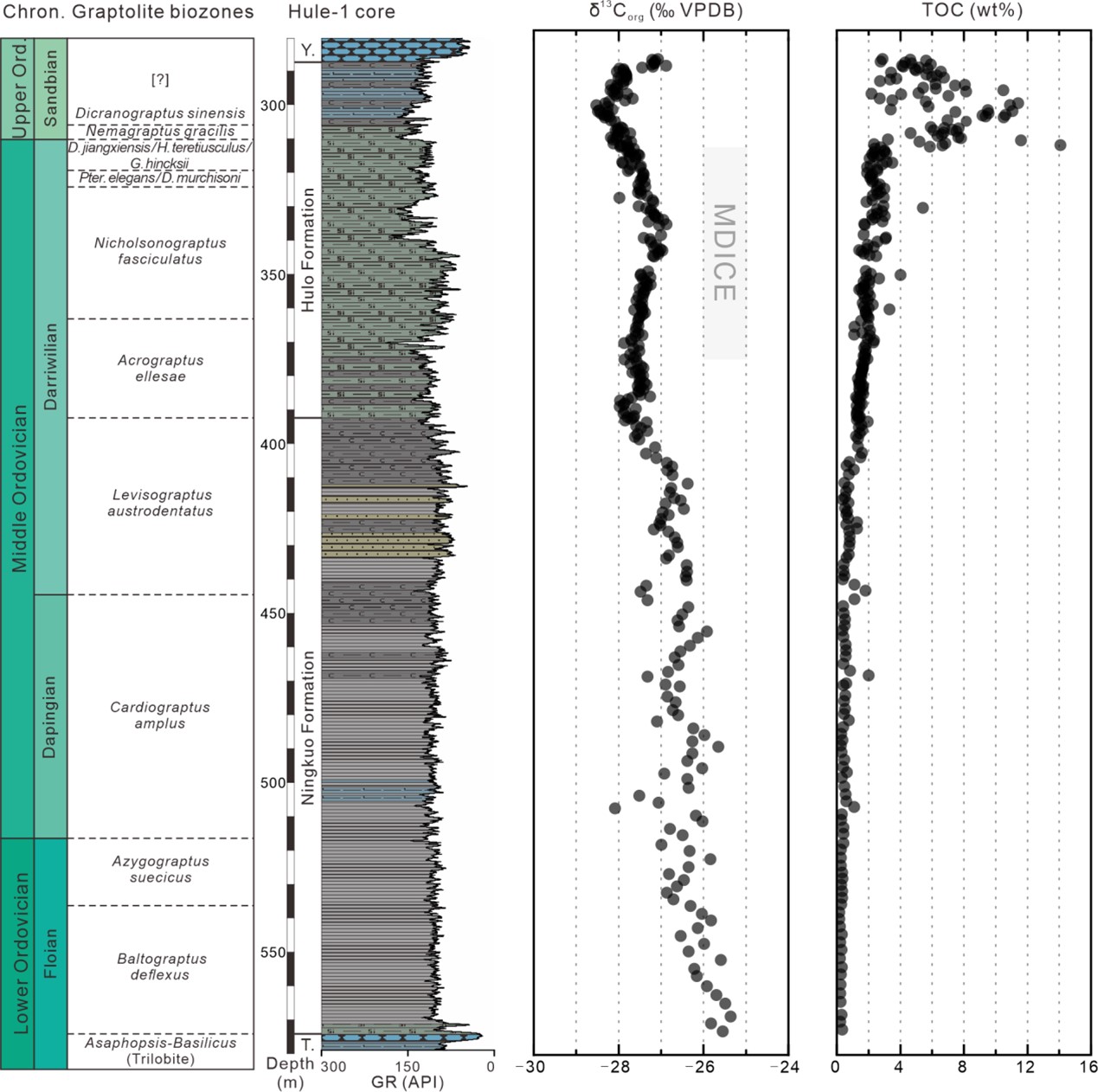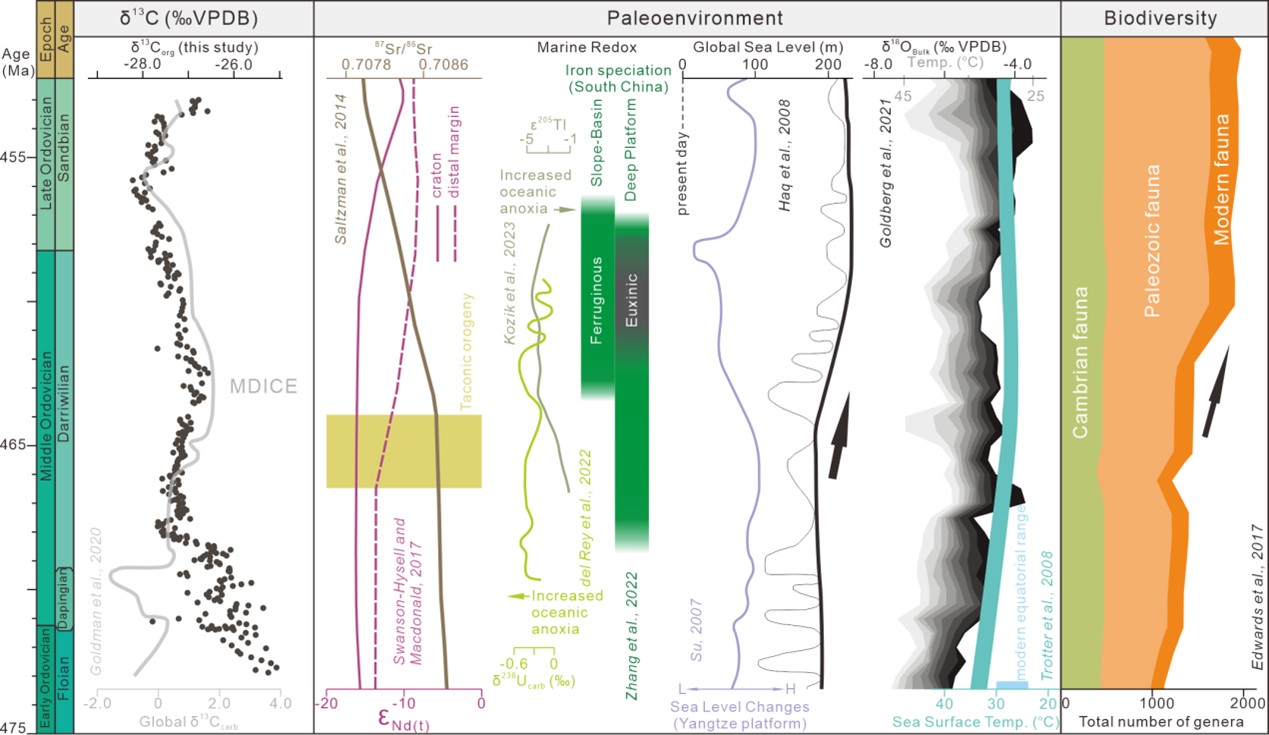The Ordovician Period represents a vital interval in Earth history, where carbon isotope record serves as an important tool for stratigraphic correlation and critical archive for deciphering paleoclimate-biosphere coevolution. While previous studies predominantly focus on δ13Ccarb data, δ13Corg records have been ignored for a long time.
Recently, Dr. LUAN, Xiaocong and Professor WU, Rongchang from Nanjing Institute of Geology and Palaeontology, Chinese Academy of Sciences (NIGPAS), in collaboration with researchers from Lund University, Friedrich-Alexander Universität Erlangen-Nürnberg, and Institute of Geology and Geophysics, CAS, present the δ13Corg sequence spanning the upper Lower–lower Upper Ordovician from the Hule-1 core, Jiangnan slope, South China, more importantly filling the knowledge gap of MDICE (Middle Darriwilian Isotopic Carbon Excursion) recognized in δ13Corg record.
This study elucidates the MDICE in deep-water depositional environments, and its significances in global carbon cycle fluctuations, providing new perspectives on environmental-biological coevolution during the Middle Ordovician. This study has recently published online in an international journal Palaeogeography, Palaeoclimatology, Palaeoecology.
The MDICE is a globally recognized positive carbon isotope excursion during the Ordovician, previously documented mainly in δ¹³Ccarb data, with only few records in organic matter. This study, for the first time, clearly identified a complete MDICE signal with an amplitude of ca. 1.1‰ in the δ13Corg record from the fine-grained siliciclastic succession from the Hule-1 core, Jiangnan slope, South China, supported by a well-constrained graptolite biostratigraphy. The excursion includes a rising limb, a peak interval, and a falling limb, spanning from the middle to late Darriwilian.
This finding challenges the traditional view that only the rising limb of MDICE is preserved in South China due to sedimentary hiatus, illustrating that this event is also well recorded in deep-water settings. Based on intercontinental correlation with both δ13Ccarb and δ13Corg records, this study confirms the global synchronicity of MDICE and suggests that it likely reflects a significant perturbation of the global carbon cycle during the Darriwilian, which may be closely linked to coeval climatic cooling, oceanic oxygenation, and the biological radiation. This study also provides a reliable δ13Corg chemostratigraphic standard for Ordovician correlation and offers a research case for further understanding the environmental-biological coevolution during the Darriwilian.
The study was supported by the Strategic Priority Research Program of the Chinese Academy of Sciences, and the National Natural Science Foundation of China.
Reference: Xiaocong Luan*, Mikael Calner, Fangyi Gong, Oliver Lehnert, Guanzhou Yan, Yuchen Zhang, Zhutong Zhang, Rongchang Wu*, 2025. High resolution Ordovician (Floian-Sandbian) carbon isotope stratigraphy from the Jiangnan slope, South China: The first complete record of the MDICE in δ13Corg and its global significance. Palaeogeography, Palaeoclimatology, Palaeoecology, 113227, https://doi.org/10.1016/j.palaeo.2025.113227.

Fig.1 Paleogeographic location of the Hule-1 core in the Jiangnan region, South China.

Fig.2 δ13Corg record and TOC content of the upper Lower–lower Upper Ordovician in the Hule-1 core.

Fig.3 The Hule-1 core δ13Corg record and compiled global δ13Ccarb trend, with comparison to paleoenvironmental factors and biological changes during the late Early–early Late Ordovician.
Download:
